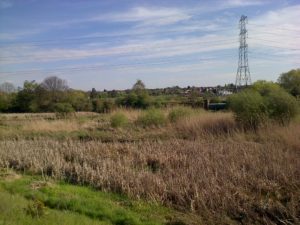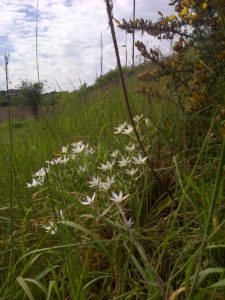As reported from other sites, Reed Warbler is back in Bexley from its African wintering grounds, and a few could be heard chuntering from out in the reedswamp at Thames Road Wetland on April 12th. A Cetti’s Warbler was present as usual, and there were a few others along the river and nearby.

Reed Warblers swop Africa for the urbanised surroundings of Crayford in spring and summer. (Photo: Chris Rose)
Of note was what may well be the first record of an adult Damselfly or Dragonfly in the Borough this year – a teneral (recently emerged) individual which didn’t stick around to be identified but was almost certainly a Large Red Damselfly.
The Green Hairstreak butterfly was first recorded at Thames Road Wetland last year by David Courtneidge of LWT and myself. The sighting of another on this sunny afternoon raises hopes that a small colony may be establishing on or around the area. Bexley hotspots for it are Crossness and the Crayford Rough/Braeburn Park complex. A male Orange Tip was seen on the site, another species first noted here in 2016, in that case by Joe Johnson. A Speckled Wood, 1 or 2 Small Tortoiseshell and a Peacock or two were also present.
Several plants of Star of Bethlehem – a bulbous perennial – had been present on the hot, gravelly Thames Road bank when I took on the role of Site Manager in 2010, but most were smothered by a pile of bricks put in by contractors for a reptile hibernaculum. I was interested see 4 flowering plants appear last spring, and very surprised to find 13 in flower now. The leaves are thin and grassy, so difficult to spot when not in bloom. There is some doubt as to whether it is native or not, and if so it has a very restricted natural distribution in the UK. In any case it will be a garden escape via road embankment aggregate here, along with a couple of varieties of Grape Hyacinth.

Star-of-Bethlehem, a garden escape, seems to be bouncing back at Thames Road Wetland after almost being lost. (Photo: Chris Rose)
A further six plants of the nationally scarce Marsh Sow-thistle were planted out, in this case ones which had somewhat miraculously come up in cracks in my front door step brickwork last spring from a plant I have been growing in a large pot nearby. The same hasn’t happened again, but it’s been a very dry start to the year …. The original and other subsequent plantings of the species at the site are leafing out nicely, with the oldest specimens having gone in back in May 2011 and now powering up to send their flower stems skywards to a height of around 9 feet over the summer.
Chris Rose. Thames21 Thames Road Wetland Site Manager.
